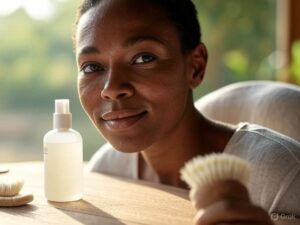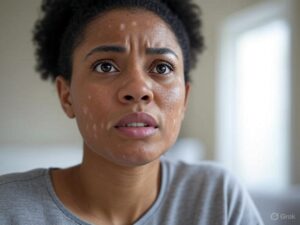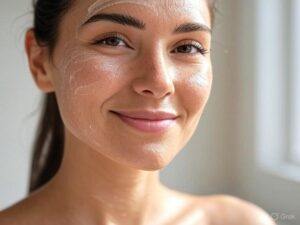
The 1 Ugly Truth About Skincare for Textured Skin, and What Actually Works
Skincare for Textured Skin is one of the most misunderstood topics in beauty and personal care. Many people with bumpy, rough, or uneven skin texture are often bombarded with quick fixes and product overloads that only make things worse. If you’ve ever felt frustrated by your skin not looking smooth no matter how hard you try, this article is for you. The goal is to help you understand what textured skin really is, why it happens, and how you can care for it without breaking the bank or damaging your skin barrier.
Let’s break it all down in a simple, honest, and real way, because the truth is, your skin deserves more than filters and false promises.
What Is Textured Skin and Why Does It Happen?
“Textured skin” means skin that doesn’t feel smooth when you touch it. Instead, it might feel rough or lumpy, like tiny bumps you can see and feel. Sometimes, the skin looks a bit dull, dry, or flaky, as if little bits are peeling off. You might also notice bigger pores or small bumps that stay there no matter what you do.
Common causes of textured skin include:
- Dead skin cell buildup
- Hormonal breakouts
- Acne scars and pits
- Sun damage
- Dehydration
- Poor skincare habits
- Genetics
Who’s affected: Anyone can have textured skin, regardless of age or gender. It’s especially common in humid or dusty environments where pores can get clogged easily.
Why it matters: Smooth skin not only boosts your confidence but also makes applying makeup or grooming easier.
It’s completely normal to have some skin texture. In fact, smooth, glass-like skin is mostly a myth sold to us by edited photos and makeup tricks. The key here isn’t about achieving perfection, but learning how to care for your skin so it becomes healthier, brighter, and more balanced.
Stop Overdoing It: Gentle Skincare for Textured Skin is Powerful
A common mistake many people make when caring for textured skin is being too harsh, either by scrubbing aggressively or overloading the skin with too many active ingredients at once. This can damage the skin’s natural barrier, leading to increased sensitivity and irritation.
For gentle yet effective care, a simpler approach often works best:
- Choose a mild cleanser that cleans without stripping moisture
- Steer clear of rough, grainy scrubs, as they can create tiny tears in the skin
- Introduce acids slowly, beginning with just once or twice a week
- Wash with lukewarm water rather than hot, which can dry out the skin
- After cleansing, gently pat the skin dry instead of rubbing to reduce friction
Over-cleansing, over-exfoliating, and layering harsh products can damage your skin’s natural rhythm. Focus on healing and protecting, not punishing your skin.
Your Textured Skin Needs Consistency, Not Miracles
There’s no overnight solution to textured skin. The real secret is consistency with a basic routine.
Here’s a skincare order that works well for textured skin:
- Cleanser – gentle and hydrating
- Toner – optional, but use soothing ones (like witch hazel-free rosewater)
- Treatment – like a mild exfoliating serum or niacinamide
- Moisturiser – lightweight, non-comedogenic
- Sunscreen – every single day
Stick to this for at least 6–8 weeks before judging results. Switching routines every week will do more harm than good.
Game-Changer Ingredients That Work on Textured Skin

There are a few star ingredients known for smoothing out skin texture, reducing clogged pores, and brightening dull areas.
Look for products that contain:
- Niacinamide: helps even skin tone and shrinks pores
- Lactic acid: a gentle exfoliant that also hydrates
- Salicylic acid: clears out pores and helps with bumps
- Azelaic acid: calms redness and refines texture
- Ceramides: essential for rebuilding the skin barrier
Choose one or two actives at most. Using too many at once leads to irritation, which makes texture worse.
A trusted brand like Paula’s Choice has a wide range of products specifically formulated for textured and sensitive skin. Their BHA Liquid Exfoliant, for example, is globally loved for a reason — but always patch-test before use.
Read Also: Simple Skin Care Mistakes That Secretly Ruin Your Glow (And What You Should Do Instead)
Natural Remedies Can Help, But Be Careful
While some natural ingredients are helpful, others can irritate textured skin even more. Always do a patch test first and avoid DIY scrubs like sugar or coffee.
Safe natural options include:
- Raw honey: anti-inflammatory and hydrating
- Aloe vera gel: soothes irritation
- Rosehip oil: rich in Vitamin A and fatty acids
- Oatmeal masks: calm and soften the skin
Stay away from lemon juice, baking soda, or toothpaste. They’re too harsh and can disrupt your skin’s pH balance.
Hydration is the Unsung Hero of Smooth Skin
Textured skin is often dehydrated skin. Dehydration can make pores more visible and skin feel rough or tight. Hydrated skin, on the other hand, looks plumper and feels smoother.
Tips to stay hydrated:
- Use humectant serums (like hyaluronic acid or glycerin)
- Layer a moisturiser that locks in that hydration
- Drink water regularly (yes, it helps)
- Use a humidifier if your room is dry
It’s not about using the most expensive cream, it’s about using the right one consistently.
Don’t Sleep on SPF, Your Texture Will Thank You
Spending time in the sun can harm the delicate parts of your skin, making it feel less smooth and soft. Even when the sky is cloudy, the sun’s rays can still quietly weaken your skin’s natural strength. Over time, this may cause dry areas, darker spots, or an uneven skin colour.
Protecting your skin with sunscreen is very important:
- Choose a sunscreen with at least SPF thirty to keep your skin safe.
- Put it on after your other skincare steps, like lotion or cream.
- If you play outside for a long time, remember to add more sunscreen every few hours.
Textured skin without sunscreen is like trying to fill a leaking bucket. You’ll never see long-term progress.
What to Avoid When You Have Textured Skin
Sometimes what you don’t do matters even more than what you do.
Avoid these habits:
- Picking or squeezing bumps
- Sleeping in makeup
- Using expired skincare
- Sharing towels or brushes
- Using too many products at once
Also, don’t compare your skin to anyone online. Everyone’s skin journey is different. Focus on your own progress.
Lifestyle Choices That Affect Skin Texture (More Than You Think)
Skincare for textured skin isn’t just about products, your lifestyle plays a big role too. Small changes in your daily habits can improve your skin’s texture and overall health.
- Stay hydrated: Drink plenty of water to keep your skin plump and healthy.
- Eat a balanced diet: Foods rich in vitamins A, C, and E (like fruits, vegetables, and nuts) support skin repair and regeneration.
- Sleep at least 7–8 hours: Skin heals itself overnight. Lack of rest triggers breakouts and dullness.
- Manage stress: Stress can trigger breakouts, so try relaxation techniques like deep breathing or exercise.
- Avoid touching your face: This prevents transferring oil and bacteria that can clog pores.
Combining these habits with a solid skincare routine will give you the best chance at smoother, healthier skin.
The Link Between Hormones and Skin Texture
Sometimes, textured skin isn’t just about what you put on your face — it’s about what’s going on beneath the surface. Hormonal changes can trigger bumps, cysts, or patches that don’t respond well to regular products.
Signs your texture might be hormone-related:
- You get flare-ups around your chin or jawline
- The bumps are deep and painful
- Your texture worsens during your menstrual cycle
- You’ve recently started or stopped birth control
If you notice any of these signs, it’s a good idea to speak with a qualified dermatologist or GP. In the UK, the NHS website has helpful information and guidance on when to seek medical treatment for persistent skin conditions.
You might need a prescription-strength treatment or help balancing your hormones, and that’s perfectly okay. There’s no shame in seeking support.
How Makeup Can Help (or Hurt) Textured Skin
Makeup can either help you feel more confident or make your texture stand out even more, depending on how you use it.
To wear makeup without making things worse:
- Always start with a clean, moisturised face
- Use a hydrating primer to smooth over dry patches
- Choose liquid foundations over powders, powders often cling to rough spots
- Avoid overly matte formulas if you have dry or flaky texture
- Don’t skip setting sprays, they can melt makeup into the skin and soften the look
But the most important rule? Always take your makeup off before bed. Sleeping in makeup clogs pores and worsens texture over time.
If you’re dealing with active texture or irritation, try going makeup-free for a few days. Let your skin breathe. It can make a world of difference.
When to See a Professional
There’s only so much you can do at home. Sometimes, textured skin needs a little extra help from trained professionals. If you’ve been consistent with your routine for a few months and still see no progress, it might be time to speak to a skin expert.
Here are signs you may need help:
- Your texture keeps getting worse
- You’re experiencing pain or itching
- Scars or pits are affecting your confidence
- Home remedies just aren’t cutting it anymore
Professional options to consider:
- Chemical peels help remove damaged outer layers
- Microneedling boosts collagen and reduces scarring
- Laser therapy targets deeper skin concerns
- Prescription retinoids stronger than over-the-counter versions
Make sure you go to certified dermatologists or skin clinics with good reviews. Avoid trendy skin treatments in shady places, your skin is not a science experiment.
Teenagers vs Adults: Textured Skin at Different Ages
Textured skin doesn’t care about age, it can show up during your teenage years, 20s, 40s, or even later. But the approach should be age-appropriate.
For teenagers:
- Keep your routine simple
- Avoid over-exfoliating
- Use salicylic acid-based cleansers only if needed
- Don’t pick at spots, this leads to long-term texture
For adults:
- Focus on hydration and gentle exfoliation
- Add antioxidants to your routine (like Vitamin C)
- Treat texture and ageing together (look into retinoids)
- Prioritise barrier repair and SPF daily
Understanding your skin’s needs at your current stage in life is key. What works at 16 won’t necessarily work at 36.
Skincare is Emotional?
Let’s be honest: textured skin can be frustrating. It can make you feel insecure, tired, and even embarrassed. But here’s what most people won’t tell you, perfect skin is a lie. Everyone, no matter how flawless they look online, has texture, pores, and bad days.
Instead of chasing perfection, aim for progress and confidence. You deserve to feel good in your skin. You deserve real solutions that don’t shame or pressure you. And you deserve to enjoy your reflection without hiding behind filters or layers.
Making Skincare a Daily Habit
Your Value is More Than Your Skin Texture, But You Still Deserve to Feel Good
This journey is not about vanity. It’s about feeling good in your body, being comfortable in your skin, and having control over your routine. Whether you’re a teenager battling hormonal breakouts or an adult dealing with stubborn texture, know this: you’re not alone.
Textured skin doesn’t mean dirty, broken, or unworthy. It simply means human. And with the right routine, a little patience, and a lot of kindness toward yourself, things can and do get better.



